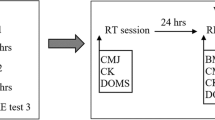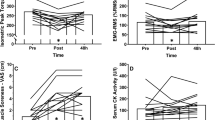Abstract
It is well established that exercise-induced muscle damage (EIMD) has a detrimental effect on endurance exercise performed in the days that follow. However, it is unknown whether such effects remain after a repeated bout of EIMD. Therefore, the purpose of this study was to examine the effects of repeated bouts of muscle-damaging exercise on sub-maximal running exercise. Nine male participants completed baseline measurements associated with a sub-maximal running bout at lactate turn point. These measurements were repeated 24–48 h after EIMD, comprising 100 squats (10 sets of 10 at 80 % body mass). Two weeks later, when symptoms from the first bout of EIMD had dissipated, all procedures performed at baseline were repeated. Results revealed significant increases in muscle soreness and creatine kinase activity and decreases in peak knee extensor torque and vertical jump performance at 24–48 h after the initial bout of EIMD. However, after the repeated bout, symptoms of EIMD were reduced from baseline at 24–48 h. Significant increases in oxygen uptake \( (\dot{V}{\text{O}}_{2} ) \), minute ventilation \( (\dot{V}_{\text{E}} ) \), blood lactate ([BLa]), rating of perceived exertion (RPE), stride frequency and decreases in stride length were observed during sub-maximal running at 24–48 h following the initial bout of EIMD. However, following the repeated bout of EIMD, \( \dot{V}{\text{O}}_{2} ,\;\dot{V}_{\text{E}} , \) [BLa], RPE and stride pattern responses during sub-maximal running remained unchanged from baseline at all time points. These findings confirm that a single resistance session protects skeletal muscle against the detrimental effects of EIMD on sub-maximal running endurance exercise.

Similar content being viewed by others
References
Armstrong RB (1984) Mechanisms of exercise-induced delayed onset muscular soreness: a brief review. Med Sci Sports Exerc 16(6):529–538
Bigland-Ritchie B, Woods JJ (1974) Integrated EMG and oxygen uptake during dynamic contractions of human muscles. J Appl Physiol 36(4):475–479
Bonacci J, Chapman A, Blanch P, Vicenzino B (2009) Neuromuscular adaptations to training, injury, and passive interventions. Sports Med 39(11):903–921
Bowers EJ, Morgan DL, Proske U (2004) Damage to the human quadriceps muscle from eccentric exercise and the training effect. J Sports Sci 22:1005–1014
Braun WA, Dutto DJ (2003) The effects of a single bout of downhill running and ensuing delayed onset of muscle soreness on running economy performed 48 h later. Eur J Appl Physiol 90:29–34
Burt DG, Twist C (2011) The effects of exercise-induced muscle damage in time-trial cycling performance. J Strength Cond Res 25(8):2185–2192
Byrne C, Eston R (2002) Maximal-intensity isometric and dynamic exercise performance after eccentric muscle actions. J Sports Sci 20:951–959
Byrne C, Twist C, Eston R (2004) Neuromuscular function after exercise-induced muscle damage. Sports Med 34(1):49–69
Chen TC, Nosaka K, Tu J (2007) Changes in running economy following downhill running. J Sports Sci 25(1):55–63
Chen TC, Nosaka K, Lin M, Chen N, Wu C (2009) Changes in running economy at different intensities following downhill running. J Sports Sci 27(11):1137–1144
Davies RC, Rowlands AV, Eston RG (2009) Effect of exercise-induced muscle damage on ventilatory and perceived exertion responses to moderate and severe intensity cycle exercise. Eur J Appl Physiol 107:11–19
Davies RC, Rowlands AV, Poole DC, Jones AM, Eston RG (2011) Eccentric exercise-induced muscle damage dissociates the lactate and gas exchange thresholds. J Sports Sci 29(2):181–189
Duranti R, Pantaleo T, Bellini F, Bongianni F, Scano G (1991) Respiratory responses induced by the activation of somatic nociceptive afferents in humans. J Appl Physiol 71:2440–2448
Elmer SJ, McDaniel J, Martin JC (2010) Alterations in neuromuscular function and perceptual responses following acute eccentric cycling exercise. Eur J Appl Physiol 110(6):1225–1233
Faul F, Erdfelder E, Lang AG, Buchner A (2007) G*Power 3: a flexible statistical power analysis for the social, behavioral, and biomedical sciences. Behav Res 39:175–191
Fridén J, Sjostrom M, Ekblom B (1983) Myofibrillar damage following intense eccentric exercise in man. Int J Sports Med 4:170–176
Gleeson M, Blannin AK, Zhu B, Brooks S, Cave R (1995) Cardiorespiratory, hormonal and haematological responses to submaximal cycling performed 2 days after eccentric or concentric exercise bouts. J Sports Sci 13:471–479
Guglielmo LG, Greco CC, Denadai BS (2009) Effects of strength training on running economy. Int J Sports Med 30(1):27–32
Hampson DB, St Clair Gibson A, Lambert MI, Noakes TD (2001) The influence of sensory cues on the perception of exertion during exercise and central regulation of exercise performance. Sports Med 31(13):935–952
Haouzi P, Chenuel B, Huszczuk A (2004) Sensing vascular distension in skeletal muscle by slow conducting afferent fibers: neuro-physiological basis and implication for respiratory control. J Appl Physiol 96:407–418
Hotta N, Sato K, Sun Z, Katayama K, Akima H, Kondo T, Ishida K (2006) Ventilatory and circulatory responses at the onset of exercise after eccentric exercise. Eur J Appl Physiol 97:598–606
Howatson G, van Someren K, Hortobagyi T (2007) Repeated bout effect after maximal eccentric exercise. Int J Sports Med 28:557–563
Jameson C, Ring C (2000) Contributions of local and central sensations to the perception of exertion during cycling: effects of work rate and cadence. J Sports Sci 18:291–298
Jones DA, Round JM (1990) Skeletal muscle in health and disease: a textbook of muscle physiology. Manchester University Press, Manchester
Komi P (2000) Stretch-shortening cycle: a powerful model to study normal and fatigued muscle. J Biomech 33:1197–1206
Kyröläinen H, Pullinen T, Candau R, Avela J, Huttunen P, Komi PV (2000) Effects of marathon running on running economy and kinematics. Eur J Appl Physiol 82:297–304
Marginson V, Rowlands AV, Gleeson NP, Eston RG (2005) Comparison of the symptoms of exercise-induced muscle damage after an initial and repeated bout of plyometric exercise in men and boys. J Appl Physiol 99:1174–1181
McHugh MP (2003) Recent advances in the understanding of the repeated bout effect: the protective effect against muscle damage from a single bout of eccentric exercise. Scand J Med Sci Sports 13:88–97
McHugh MP, Tetro DT (2003) Changes in the relationship between joint angle and torque production associated with the repeated bout effect. J Sports Sci 21:927–932
McHugh MP, Connolly DAJ, Eston RG, Gleim GW (1999) Exercise-induced muscle damage and potential mechanisms for the repeated bout effect. Sports Med 27(3):157–170
Mense S (1977) Nervous outflow from skeletal muscle following chemical noxious stimulation. J Physiol 267:75–88
Nicol C, Komi PV, Horita T, Kyrolainen H, Takala TES (1996) Reduced stretch-reflex sensitivity after exhausting stretch–shortening cycle exercise. Eur J Appl Physiol 72:401–409
Nosaka K, Clarkson PM (1995) Muscle damage following repeated bouts of high force eccentric exercise. Med Sci Sports Exerc 27(9):1263–1269
Paschalis V, Nikolaidis MG, Theodorou AA, Panayiotou G, Fatouros IG, Koutedakis Y, Jamurtas AZ (2011) A weekly bout of eccentric exercise is sufficient to induce health-promoting effects. Med Sci Sports Exerc 43(1):64–73
Price DD, McGrath PA, Rafii A, Buckingham B (1983) The validation of visual analogue scales as ratio scale measures for chronic and experimental pain. Pain 17:45–56
Scott KE, Rozenek R, Russo AC, Crussemeyer JA, Lacourse MG (2003) Effects of delayed onset muscle soreness on selected physiological responses to submaximal running. J Strength Cond Res 17(4):652–658
Starbuck C, Eston R (2011) Exercise-induced muscle damage and the repeated bout effect: evidence for cross transfer. Eur J Appl Physiol. doi:10.1007/s00421-011-2053-6
Stevens JP (2002) Applied multivariate statistics for the social sciences. Erlbaum Mahwah, New Jersey
Twist C, Eston R (2009) The effect of exercise-induced muscle damage on perceived exertion and cycling performance. Eur J Appl Physiol 105:559–567
Vincent HK, Vincent KR (1997) The effect of training status on the serum creatine kinase response, soreness and muscle function following resistance exercise. Int J Sports Med 18:431–437
Warren GL, Lowe DA, Armstrong RB (1999) Measurement tools used in the study of eccentric contraction-induced injury. Sports Med 27(1):43–59
Warren GL, Hermann KM, Ingalls CP, Masselli MR, Armstrong RB (2000) Decreased EMG median frequency during a second bout of eccentric contractions. Med Sci Sports Exerc 32(4):820–829
Acknowledgments
The authors wish to thank all participants who took part in the study and the Human Performance Laboratory staff for their technical support.
Conflict of interest
The authors declare that they have no conflict of interest.
Ethical standards
The authors declare that the experiments carried out complied with the current UK laws.
Author information
Authors and Affiliations
Corresponding author
Additional information
Communicated by Martin Flueck.
Rights and permissions
About this article
Cite this article
Burt, D., Lamb, K., Nicholas, C. et al. Effects of repeated bouts of squatting exercise on sub-maximal endurance running performance. Eur J Appl Physiol 113, 285–293 (2013). https://doi.org/10.1007/s00421-012-2437-2
Received:
Accepted:
Published:
Issue Date:
DOI: https://doi.org/10.1007/s00421-012-2437-2




